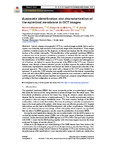Automatic Identification and Characterization of the Epiretinal Membrane in OCT Images

Use this link to cite
http://hdl.handle.net/2183/23992Collections
- Investigación (FIC) [1685]
Metadata
Show full item recordTitle
Automatic Identification and Characterization of the Epiretinal Membrane in OCT ImagesDate
2019-07-16Citation
Sergio Baamonde, Joaquim de Moura, Jorge Novo, Pablo Charlón, and Marcos Ortega, "Automatic identification and characterization of the epiretinal membrane in OCT images," Biomed. Opt. Express 10, 4018-4033 (2019)
Abstract
[Abstract] Optical coherence tomography (OCT) is a medical image modality that is used to capture, non-invasively, high-resolution cross-sectional images of the retinal tissue. These images constitute a suitable scenario for the diagnosis of relevant eye diseases like the vitreomacular traction or the diabetic retinopathy. The identification of the epiretinal membrane (ERM) is a relevant issue as its presence constitutes a symptom of diseases like the macular edema, deteriorating the vision quality of the patients. This work presents an automatic methodology for the identification of the ERM presence in OCT scans. Initially, a complete and heterogeneous set of features was defined to capture the properties of the ERM in the OCT scans. Selected features went through a feature selection process to further improve the method efficiency. Additionally, representative classifiers were trained and tested to measure the suitability of the proposed approach. The method was tested with a dataset of 285 OCT scans labeled by a specialist. In particular, 3,600 samples were equally extracted from the dataset, representing zones with and without ERM presence. Different experiments were conducted to reach the most suitable approach. Finally, selected classifiers were trained and compared using different metrics, providing in the best configuration an accuracy of 89.35%.
Keywords
Image analysis
Image processing
Laser therapy
Medical imaging
Optical coherence tomography
Visual acuity
Image processing
Laser therapy
Medical imaging
Optical coherence tomography
Visual acuity
Editor version
Rights
© 2019 Optical Society of America under the terms of the OSA Open Access Publishing Agreement (https://doi.org/10.1364/OA_License_v1)
ISSN
2156-7085





